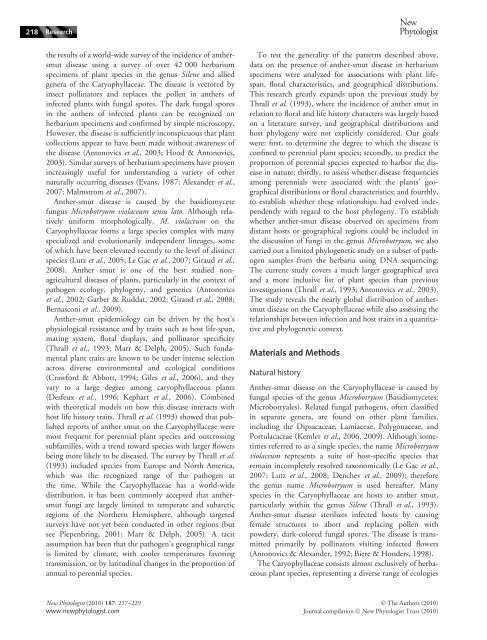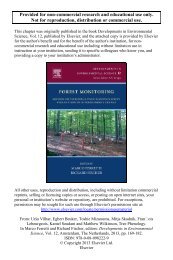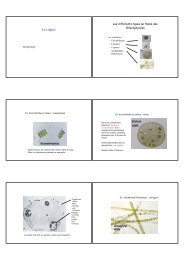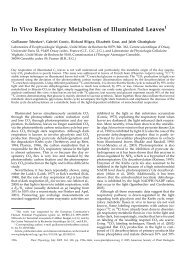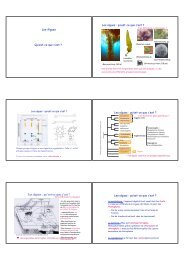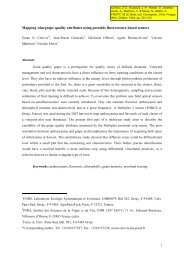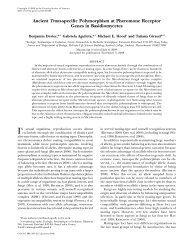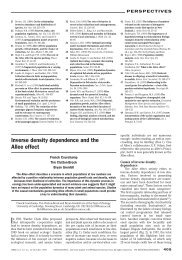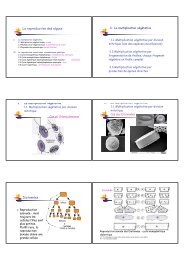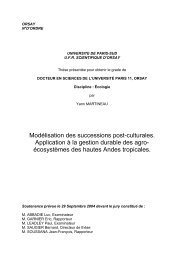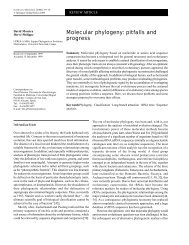Distribution of the anthersmut pathogen Microbotryum on species of ...
Distribution of the anthersmut pathogen Microbotryum on species of ...
Distribution of the anthersmut pathogen Microbotryum on species of ...
Create successful ePaper yourself
Turn your PDF publications into a flip-book with our unique Google optimized e-Paper software.
218 ResearchNewPhytologist<str<strong>on</strong>g>the</str<strong>on</strong>g> results <str<strong>on</strong>g>of</str<strong>on</strong>g> a world-wide survey <str<strong>on</strong>g>of</str<strong>on</strong>g> <str<strong>on</strong>g>the</str<strong>on</strong>g> incidence <str<strong>on</strong>g>of</str<strong>on</strong>g> an<str<strong>on</strong>g>the</str<strong>on</strong>g>rsmutdisease using a survey <str<strong>on</strong>g>of</str<strong>on</strong>g> over 42 000 herbariumspecimens <str<strong>on</strong>g>of</str<strong>on</strong>g> plant <strong>species</strong> in <str<strong>on</strong>g>the</str<strong>on</strong>g> genus Silene and alliedgenera <str<strong>on</strong>g>of</str<strong>on</strong>g> <str<strong>on</strong>g>the</str<strong>on</strong>g> Caryophyllaceae. The disease is vectored byinsect pollinators and replaces <str<strong>on</strong>g>the</str<strong>on</strong>g> pollen in an<str<strong>on</strong>g>the</str<strong>on</strong>g>rs <str<strong>on</strong>g>of</str<strong>on</strong>g>infected plants with fungal spores. The dark fungal sporesin <str<strong>on</strong>g>the</str<strong>on</strong>g> an<str<strong>on</strong>g>the</str<strong>on</strong>g>rs <str<strong>on</strong>g>of</str<strong>on</strong>g> infected plants can be recognized <strong>on</strong>herbarium specimens and c<strong>on</strong>firmed by simple microscopy.However, <str<strong>on</strong>g>the</str<strong>on</strong>g> disease is sufficiently inc<strong>on</strong>spicuous that plantcollecti<strong>on</strong>s appear to have been made without awareness <str<strong>on</strong>g>of</str<strong>on</strong>g><str<strong>on</strong>g>the</str<strong>on</strong>g> disease (Ant<strong>on</strong>ovics et al., 2003; Hood & Ant<strong>on</strong>ovics,2003). Similar surveys <str<strong>on</strong>g>of</str<strong>on</strong>g> herbarium specimens have provenincreasingly useful for understanding a variety <str<strong>on</strong>g>of</str<strong>on</strong>g> o<str<strong>on</strong>g>the</str<strong>on</strong>g>rnaturally occurring diseases (Evans, 1987; Alexander et al.,2007; Malmstrom et al., 2007).An<str<strong>on</strong>g>the</str<strong>on</strong>g>r-smut disease is caused by <str<strong>on</strong>g>the</str<strong>on</strong>g> basidiomycetefungus <str<strong>on</strong>g>Microbotryum</str<strong>on</strong>g> violaceum sensu lato. Although relativelyuniform morphologically, M. violaceum <strong>on</strong> <str<strong>on</strong>g>the</str<strong>on</strong>g>Caryophyllaceae forms a large <strong>species</strong> complex with manyspecialized and evoluti<strong>on</strong>arily independent lineages, some<str<strong>on</strong>g>of</str<strong>on</strong>g> which have been elevated recently to <str<strong>on</strong>g>the</str<strong>on</strong>g> level <str<strong>on</strong>g>of</str<strong>on</strong>g> distinct<strong>species</strong> (Lutz et al., 2005; Le Gac et al., 2007; Giraud et al.,2008). An<str<strong>on</strong>g>the</str<strong>on</strong>g>r smut is <strong>on</strong>e <str<strong>on</strong>g>of</str<strong>on</strong>g> <str<strong>on</strong>g>the</str<strong>on</strong>g> best studied n<strong>on</strong>agriculturaldiseases <str<strong>on</strong>g>of</str<strong>on</strong>g> plants, particularly in <str<strong>on</strong>g>the</str<strong>on</strong>g> c<strong>on</strong>text <str<strong>on</strong>g>of</str<strong>on</strong>g><str<strong>on</strong>g>pathogen</str<strong>on</strong>g> ecology, phylogeny, and genetics (Ant<strong>on</strong>ovicset al., 2002; Garber & Ruddat, 2002; Giraud et al., 2008;Bernasc<strong>on</strong>i et al., 2009).An<str<strong>on</strong>g>the</str<strong>on</strong>g>r-smut epidemiology can be driven by <str<strong>on</strong>g>the</str<strong>on</strong>g> host’sphysiological resistance and by traits such as host life-span,mating system, floral displays, and pollinator specificity(Thrall et al., 1993; Marr & Delph, 2005). Such fundamentalplant traits are known to be under intense selecti<strong>on</strong>across diverse envir<strong>on</strong>mental and ecological c<strong>on</strong>diti<strong>on</strong>s(Crawford & Abbott, 1994; Giles et al., 2006), and <str<strong>on</strong>g>the</str<strong>on</strong>g>yvary to a large degree am<strong>on</strong>g caryophyllaceous plants(Desfeux et al., 1996; Kephart et al., 2006). Combinedwith <str<strong>on</strong>g>the</str<strong>on</strong>g>oretical models <strong>on</strong> how this disease interacts withhost life history traits, Thrall et al. (1993) showed that publishedreports <str<strong>on</strong>g>of</str<strong>on</strong>g> an<str<strong>on</strong>g>the</str<strong>on</strong>g>r smut <strong>on</strong> <str<strong>on</strong>g>the</str<strong>on</strong>g> Caryophyllaceae weremost frequent for perennial plant <strong>species</strong> and outcrossingsubfamilies, with a trend toward <strong>species</strong> with larger flowersbeing more likely to be diseased. The survey by Thrall et al.(1993) included <strong>species</strong> from Europe and North America,which was <str<strong>on</strong>g>the</str<strong>on</strong>g> recognized range <str<strong>on</strong>g>of</str<strong>on</strong>g> <str<strong>on</strong>g>the</str<strong>on</strong>g> <str<strong>on</strong>g>pathogen</str<strong>on</strong>g> at<str<strong>on</strong>g>the</str<strong>on</strong>g> time. While <str<strong>on</strong>g>the</str<strong>on</strong>g> Caryophyllaceae has a world-widedistributi<strong>on</strong>, it has been comm<strong>on</strong>ly accepted that an<str<strong>on</strong>g>the</str<strong>on</strong>g>rsmutfungi are largely limited to temperate and subarcticregi<strong>on</strong>s <str<strong>on</strong>g>of</str<strong>on</strong>g> <str<strong>on</strong>g>the</str<strong>on</strong>g> Nor<str<strong>on</strong>g>the</str<strong>on</strong>g>rn Hemisphere, although targetedsurveys have not yet been c<strong>on</strong>ducted in o<str<strong>on</strong>g>the</str<strong>on</strong>g>r regi<strong>on</strong>s (butsee Piepenbring, 2001; Marr & Delph, 2005). A tacitassumpti<strong>on</strong> has been that <str<strong>on</strong>g>the</str<strong>on</strong>g> <str<strong>on</strong>g>pathogen</str<strong>on</strong>g>’s geographical rangeis limited by climate, with cooler temperatures favoringtransmissi<strong>on</strong>, or by latitudinal changes in <str<strong>on</strong>g>the</str<strong>on</strong>g> proporti<strong>on</strong> <str<strong>on</strong>g>of</str<strong>on</strong>g>annual to perennial <strong>species</strong>.To test <str<strong>on</strong>g>the</str<strong>on</strong>g> generality <str<strong>on</strong>g>of</str<strong>on</strong>g> <str<strong>on</strong>g>the</str<strong>on</strong>g> patterns described above,data <strong>on</strong> <str<strong>on</strong>g>the</str<strong>on</strong>g> presence <str<strong>on</strong>g>of</str<strong>on</strong>g> an<str<strong>on</strong>g>the</str<strong>on</strong>g>r-smut disease in herbariumspecimens were analyzed for associati<strong>on</strong>s with plant lifespan,floral characteristics, and geographical distributi<strong>on</strong>s.This research greatly expands up<strong>on</strong> <str<strong>on</strong>g>the</str<strong>on</strong>g> previous study byThrall et al. (1993), where <str<strong>on</strong>g>the</str<strong>on</strong>g> incidence <str<strong>on</strong>g>of</str<strong>on</strong>g> an<str<strong>on</strong>g>the</str<strong>on</strong>g>r smut inrelati<strong>on</strong> to floral and life history characters was largely based<strong>on</strong> a literature survey, and geographical distributi<strong>on</strong>s andhost phylogeny were not explicitly c<strong>on</strong>sidered. Our goalswere: first, to determine <str<strong>on</strong>g>the</str<strong>on</strong>g> degree to which <str<strong>on</strong>g>the</str<strong>on</strong>g> disease isc<strong>on</strong>fined to perennial plant <strong>species</strong>; sec<strong>on</strong>dly, to predict <str<strong>on</strong>g>the</str<strong>on</strong>g>proporti<strong>on</strong> <str<strong>on</strong>g>of</str<strong>on</strong>g> perennial <strong>species</strong> expected to harbor <str<strong>on</strong>g>the</str<strong>on</strong>g> diseasein nature; thirdly, to assess whe<str<strong>on</strong>g>the</str<strong>on</strong>g>r disease frequenciesam<strong>on</strong>g perennials were associated with <str<strong>on</strong>g>the</str<strong>on</strong>g> plants’ geographicaldistributi<strong>on</strong>s or floral characteristics; and fourthly,to establish whe<str<strong>on</strong>g>the</str<strong>on</strong>g>r <str<strong>on</strong>g>the</str<strong>on</strong>g>se relati<strong>on</strong>ships had evolved independentlywith regard to <str<strong>on</strong>g>the</str<strong>on</strong>g> host phylogeny. To establishwhe<str<strong>on</strong>g>the</str<strong>on</strong>g>r an<str<strong>on</strong>g>the</str<strong>on</strong>g>r-smut disease observed <strong>on</strong> specimens fromdistant hosts or geographical regi<strong>on</strong>s could be included in<str<strong>on</strong>g>the</str<strong>on</strong>g> discussi<strong>on</strong> <str<strong>on</strong>g>of</str<strong>on</strong>g> fungi in <str<strong>on</strong>g>the</str<strong>on</strong>g> genus <str<strong>on</strong>g>Microbotryum</str<strong>on</strong>g>, we alsocarried out a limited phylogenetic study <strong>on</strong> a subset <str<strong>on</strong>g>of</str<strong>on</strong>g> <str<strong>on</strong>g>pathogen</str<strong>on</strong>g>samples from <str<strong>on</strong>g>the</str<strong>on</strong>g> herbaria using DNA sequencing.The current study covers a much larger geographical areaand a more inclusive list <str<strong>on</strong>g>of</str<strong>on</strong>g> plant <strong>species</strong> than previousinvestigati<strong>on</strong>s (Thrall et al., 1993; Ant<strong>on</strong>ovics et al., 2003).The study reveals <str<strong>on</strong>g>the</str<strong>on</strong>g> nearly global distributi<strong>on</strong> <str<strong>on</strong>g>of</str<strong>on</strong>g> an<str<strong>on</strong>g>the</str<strong>on</strong>g>rsmutdisease <strong>on</strong> <str<strong>on</strong>g>the</str<strong>on</strong>g> Caryophyllaceae while also assessing <str<strong>on</strong>g>the</str<strong>on</strong>g>relati<strong>on</strong>ships between infecti<strong>on</strong> and host traits in a quantitativeand phylogenetic c<strong>on</strong>text.Materials and MethodsNatural historyAn<str<strong>on</strong>g>the</str<strong>on</strong>g>r-smut disease <strong>on</strong> <str<strong>on</strong>g>the</str<strong>on</strong>g> Caryophyllaceae is caused byfungal <strong>species</strong> <str<strong>on</strong>g>of</str<strong>on</strong>g> <str<strong>on</strong>g>the</str<strong>on</strong>g> genus <str<strong>on</strong>g>Microbotryum</str<strong>on</strong>g> (Basidiomycetes:Microbotryales). Related fungal <str<strong>on</strong>g>pathogen</str<strong>on</strong>g>s, <str<strong>on</strong>g>of</str<strong>on</strong>g>ten classifiedin separate genera, are found <strong>on</strong> o<str<strong>on</strong>g>the</str<strong>on</strong>g>r plant families,including <str<strong>on</strong>g>the</str<strong>on</strong>g> Dipsacaceae, Lamiaceae, Polyg<strong>on</strong>aceae, andPortulacaceae (Kemler et al., 2006, 2009). Although sometimesreferred to as a single <strong>species</strong>, <str<strong>on</strong>g>the</str<strong>on</strong>g> name <str<strong>on</strong>g>Microbotryum</str<strong>on</strong>g>violaceum represents a suite <str<strong>on</strong>g>of</str<strong>on</strong>g> host-specific <strong>species</strong> thatremain incompletely resolved tax<strong>on</strong>omically (Le Gac et al.,2007; Lutz et al., 2008; Denchev et al., 2009); <str<strong>on</strong>g>the</str<strong>on</strong>g>refore<str<strong>on</strong>g>the</str<strong>on</strong>g> genus name <str<strong>on</strong>g>Microbotryum</str<strong>on</strong>g> is used hereafter. Many<strong>species</strong> in <str<strong>on</strong>g>the</str<strong>on</strong>g> Caryophyllaceae are hosts to an<str<strong>on</strong>g>the</str<strong>on</strong>g>r smut,particularly within <str<strong>on</strong>g>the</str<strong>on</strong>g> genus Silene (Thrall et al., 1993).An<str<strong>on</strong>g>the</str<strong>on</strong>g>r-smut disease sterilizes infected hosts by causingfemale structures to abort and replacing pollen withpowdery, dark-colored fungal spores. The disease is transmittedprimarily by pollinators visiting infected flowers(Ant<strong>on</strong>ovics & Alexander, 1992; Biere & H<strong>on</strong>ders, 1998).The Caryophyllaceae c<strong>on</strong>sists almost exclusively <str<strong>on</strong>g>of</str<strong>on</strong>g> herbaceousplant <strong>species</strong>, representing a diverse range <str<strong>on</strong>g>of</str<strong>on</strong>g> ecologiesNew Phytologist (2010) 187: 217–229www.newphytologist.comÓ The Authors (2010)Journal compilati<strong>on</strong> Ó New Phytologist Trust (2010)


